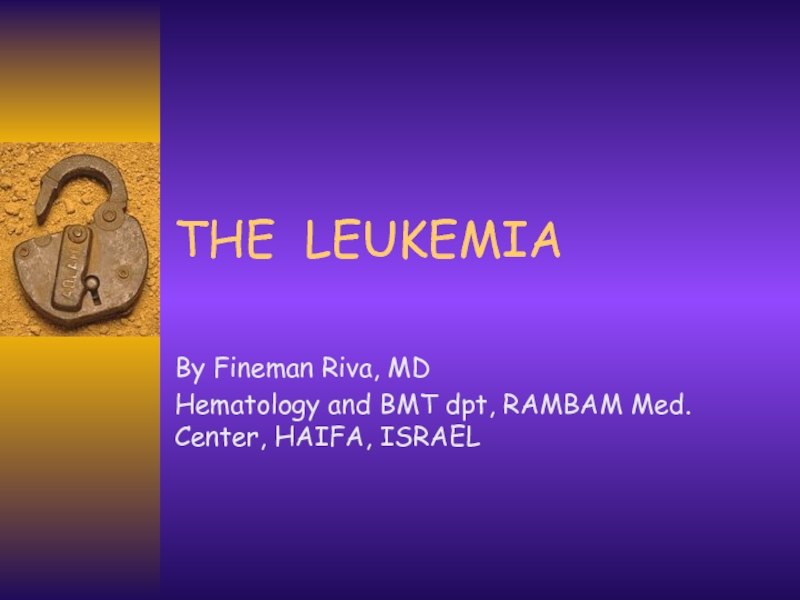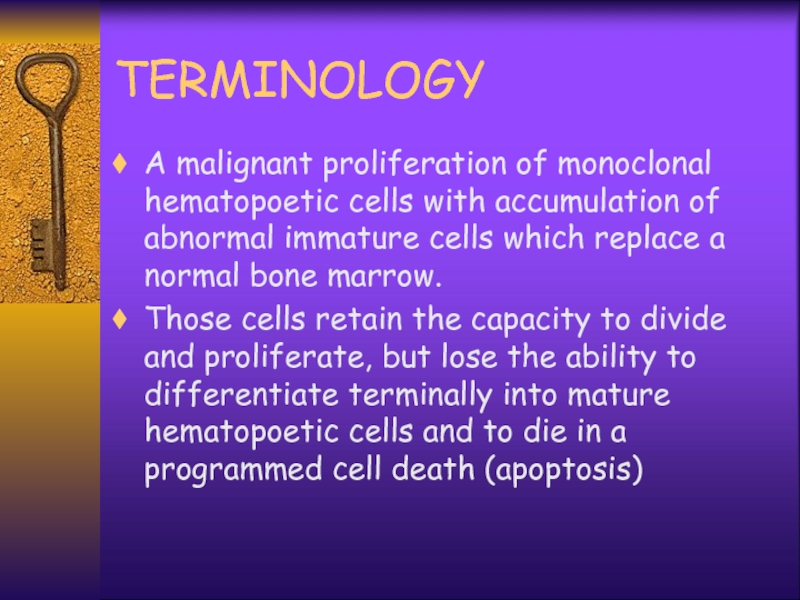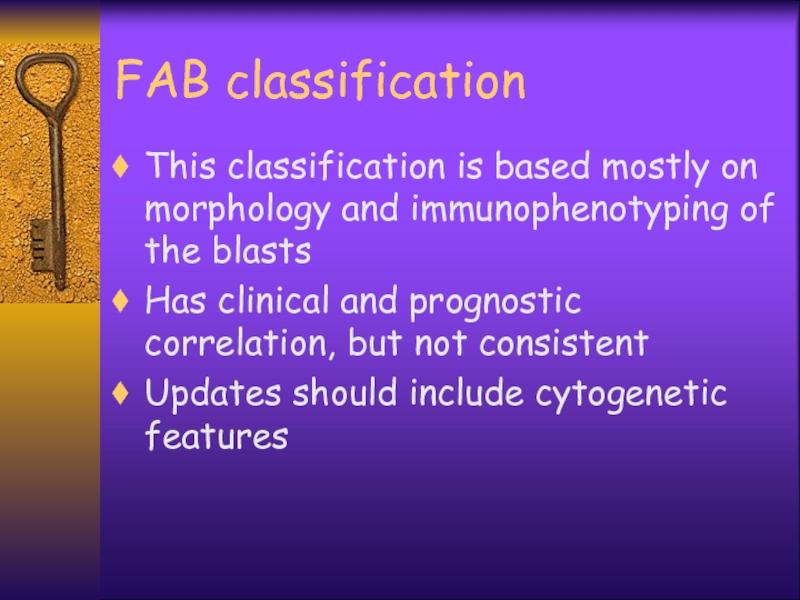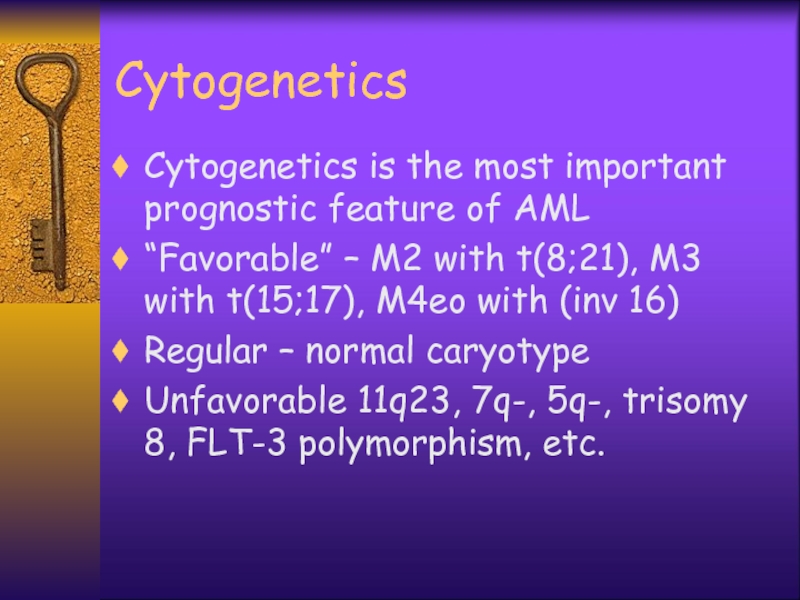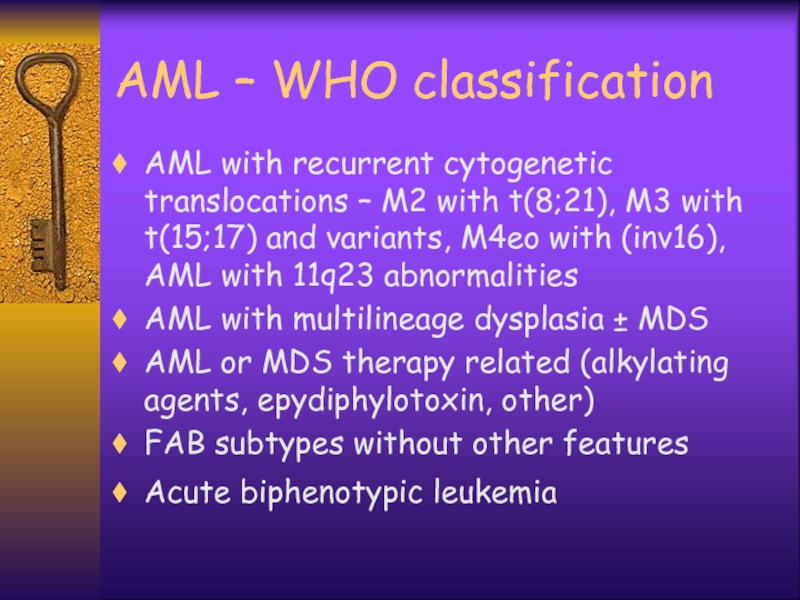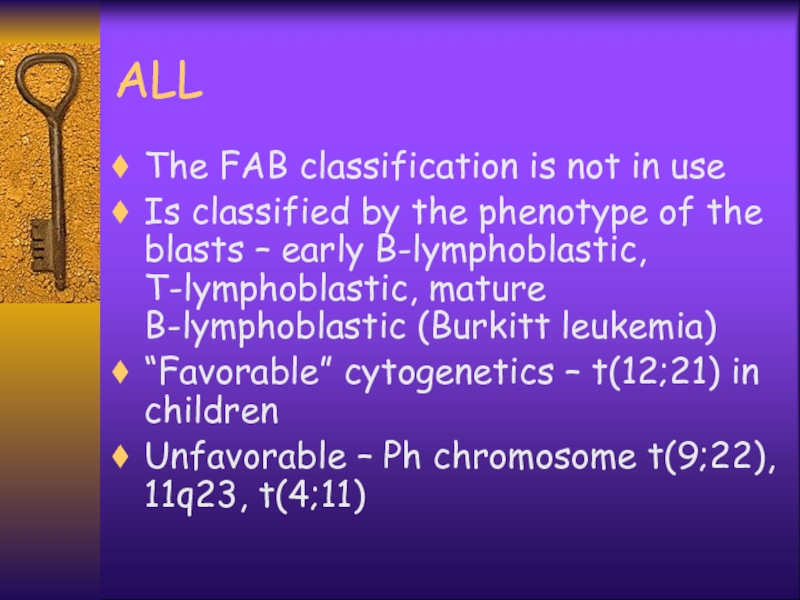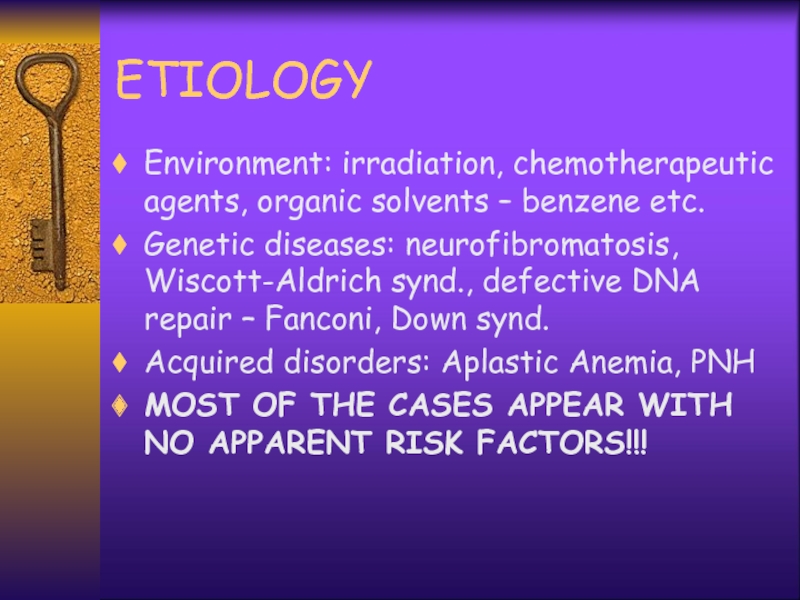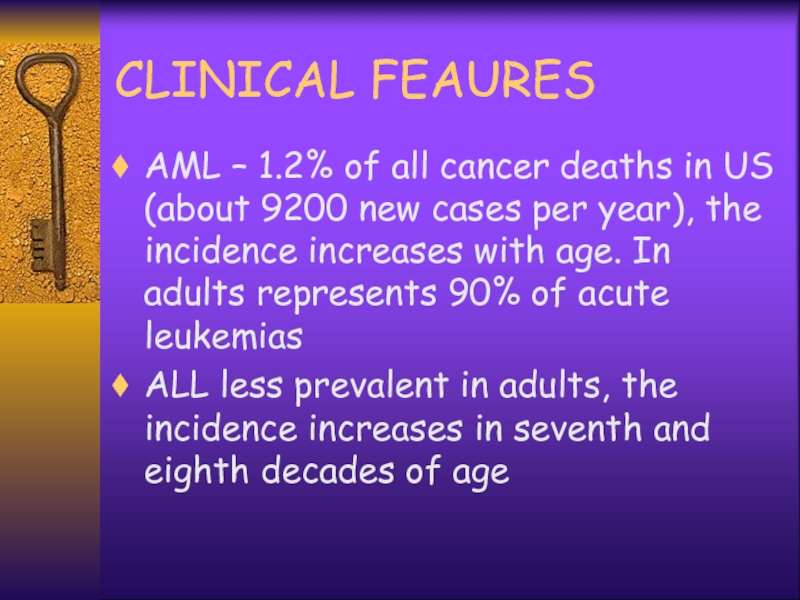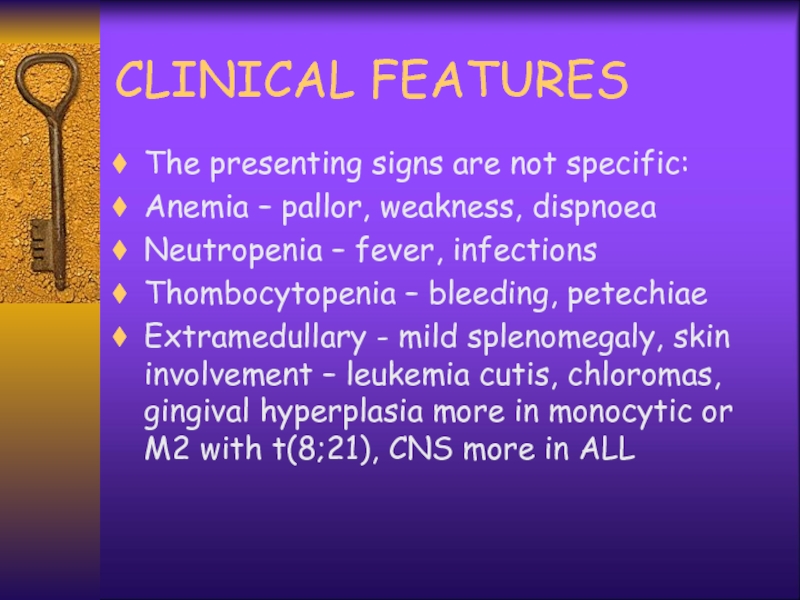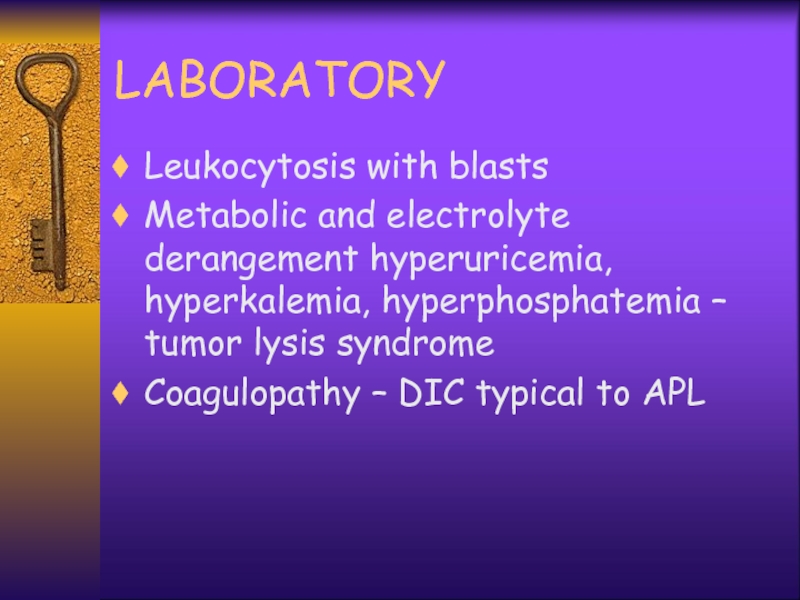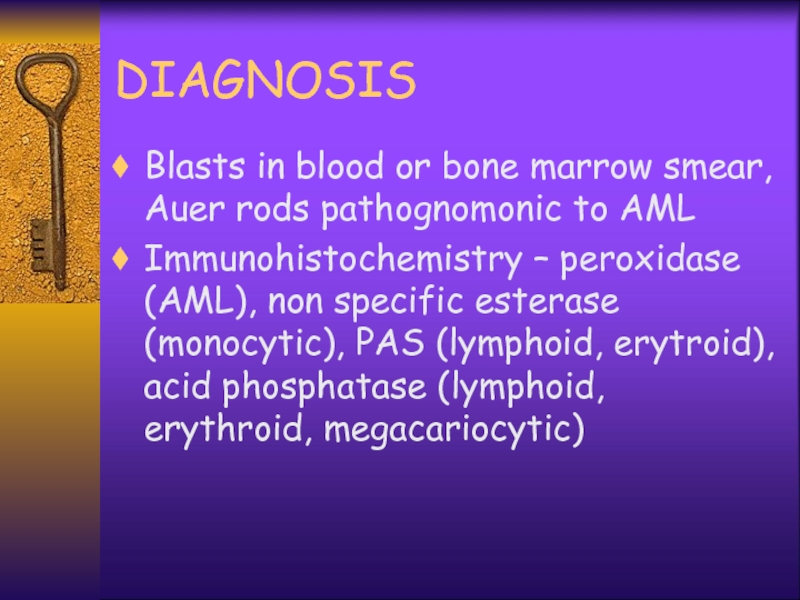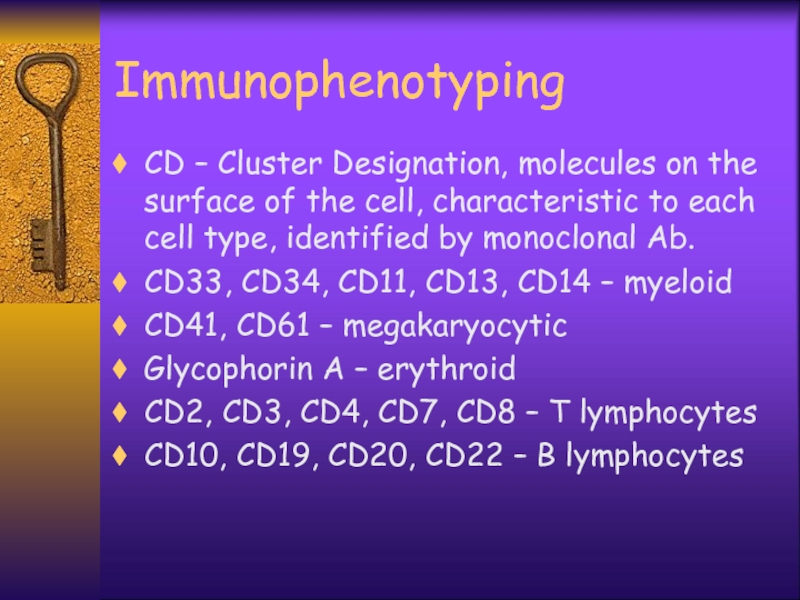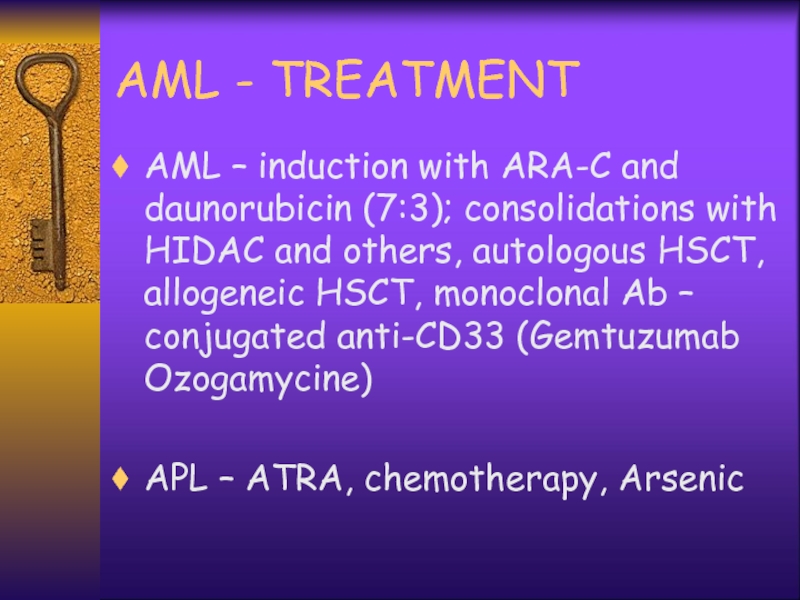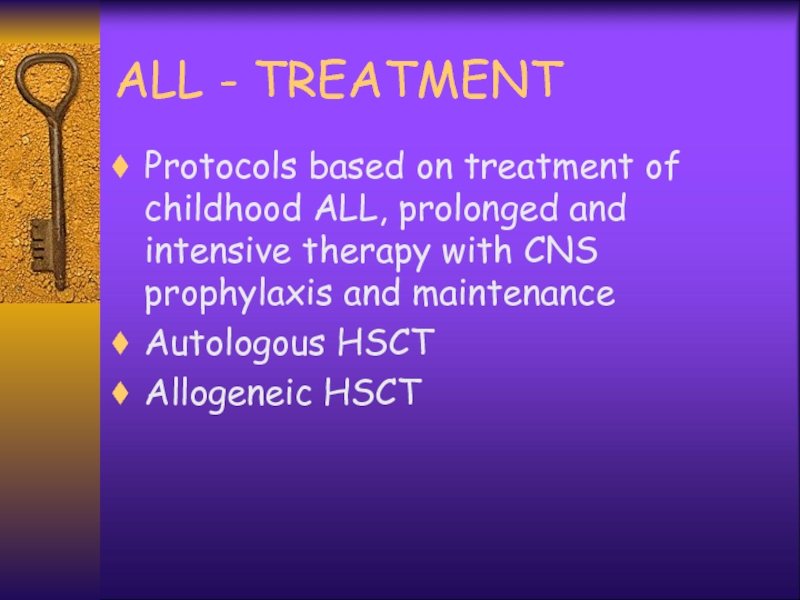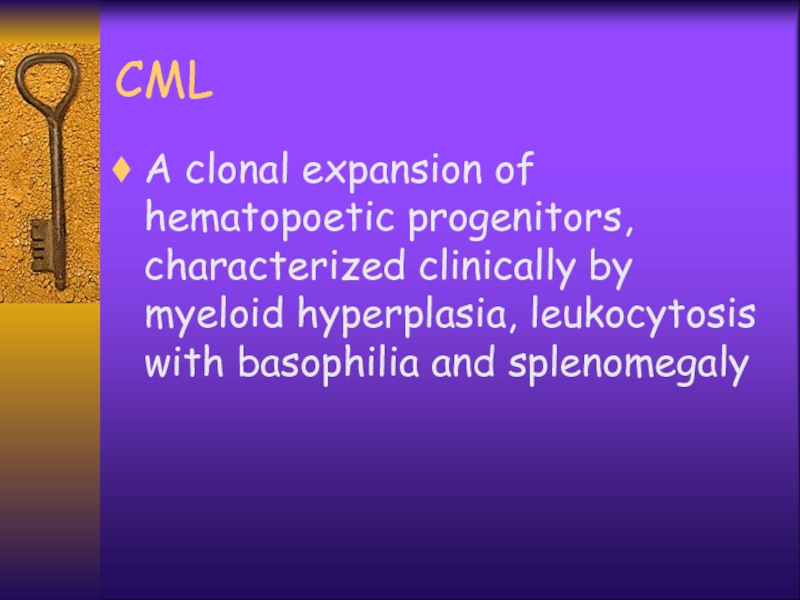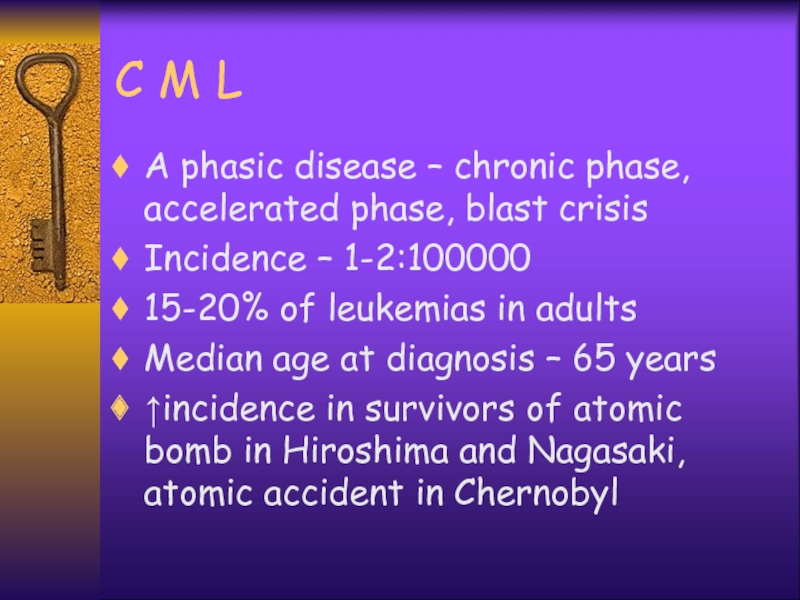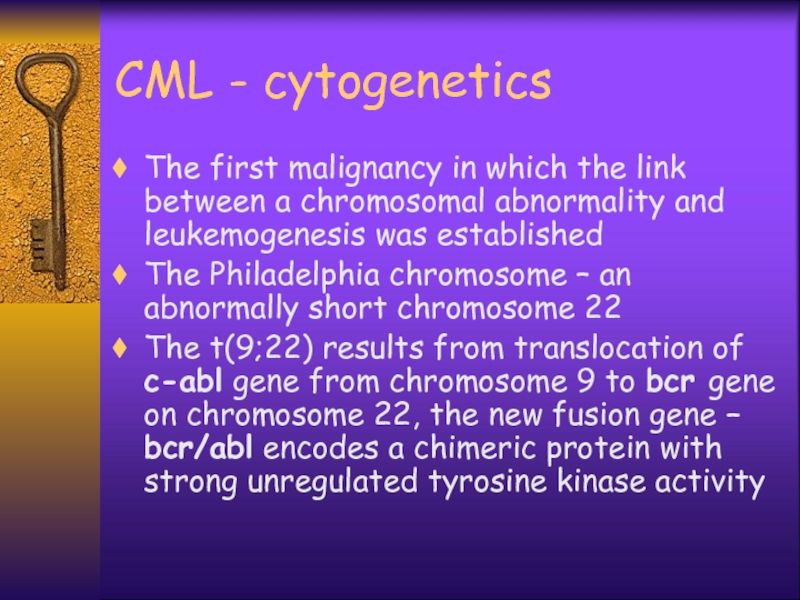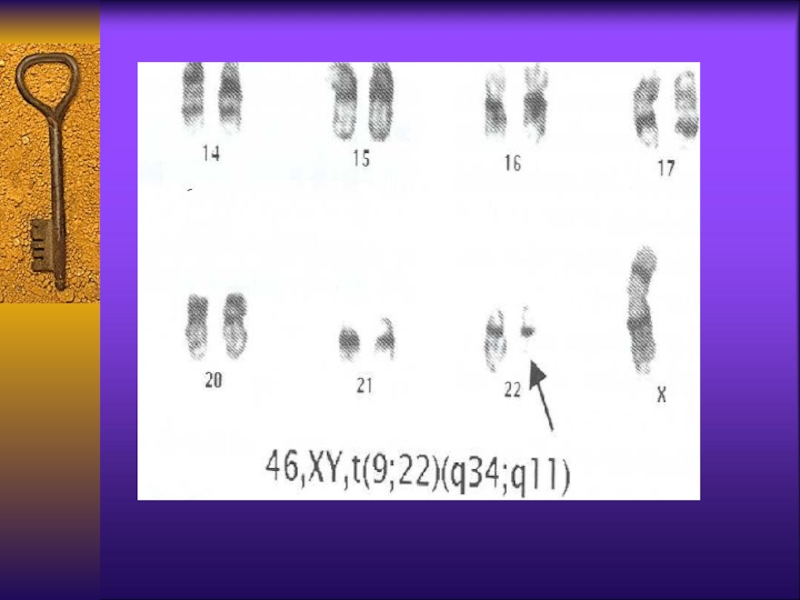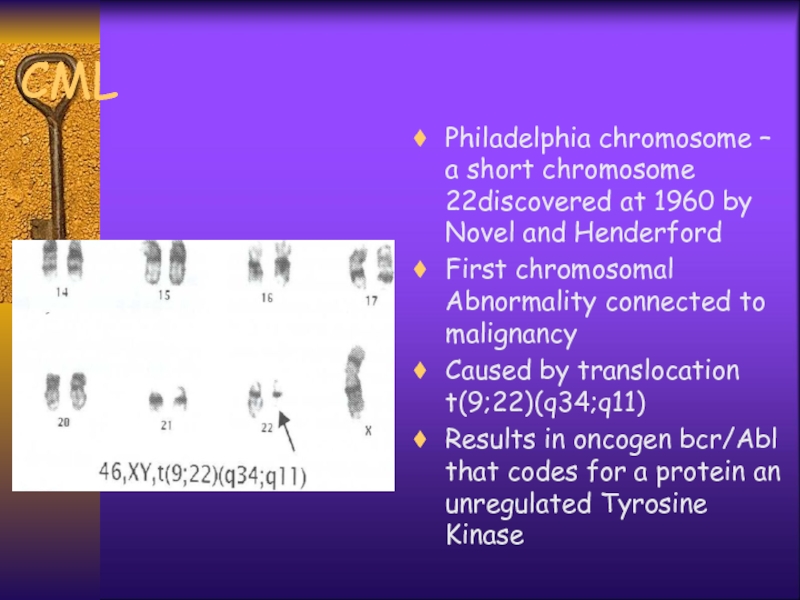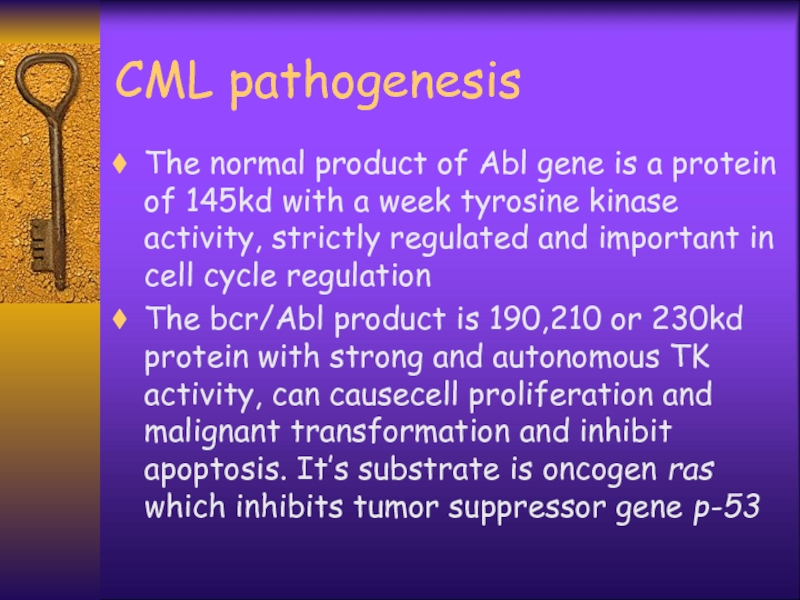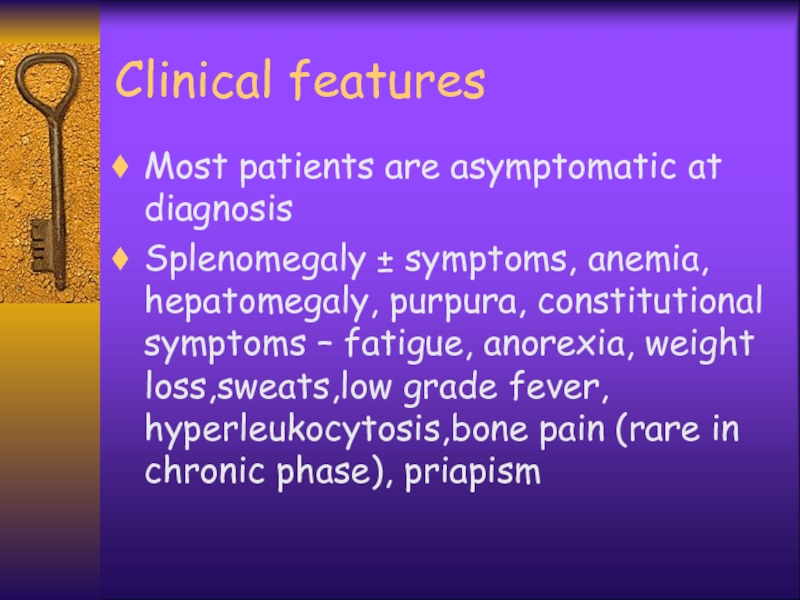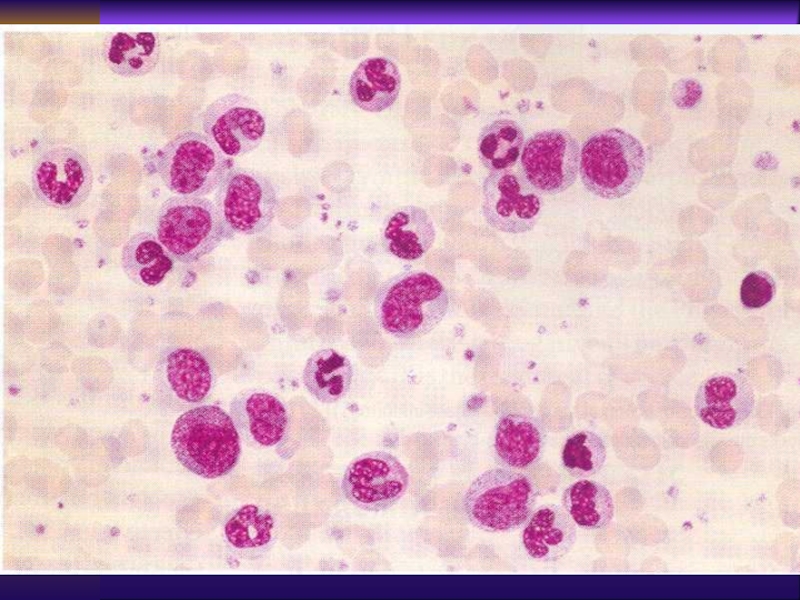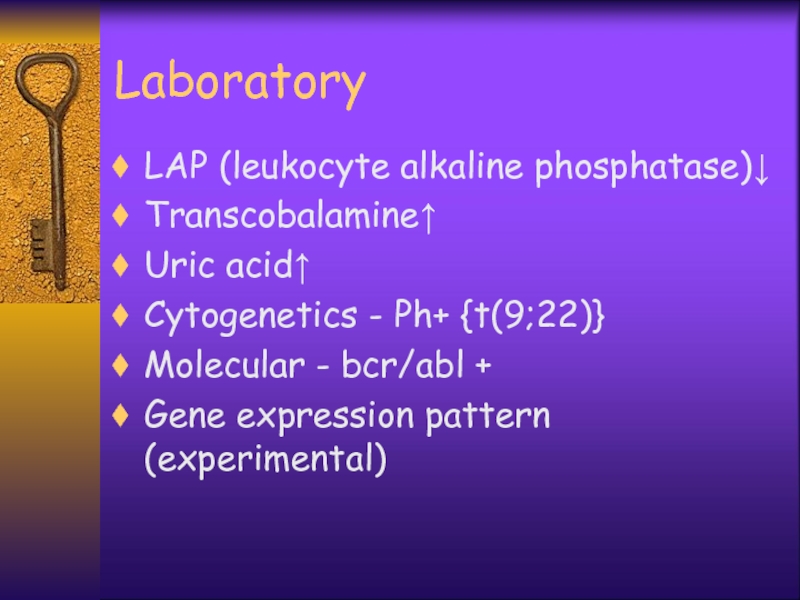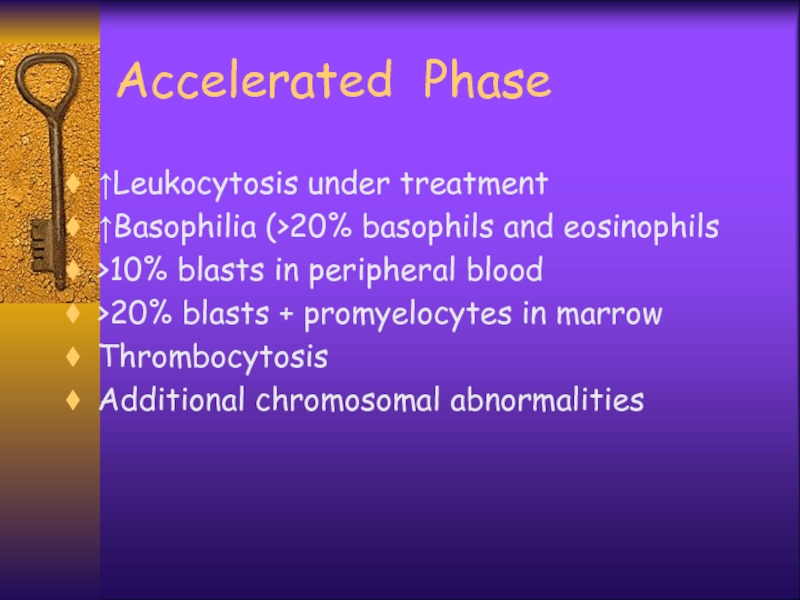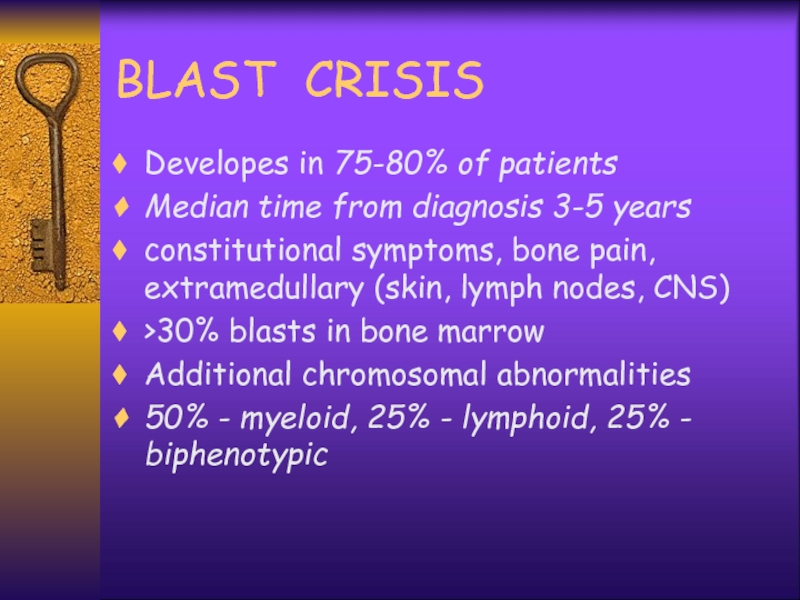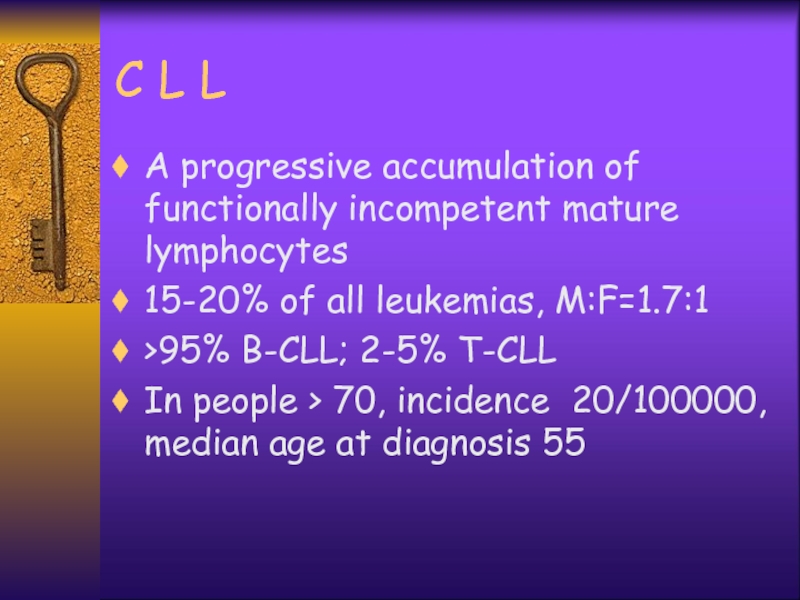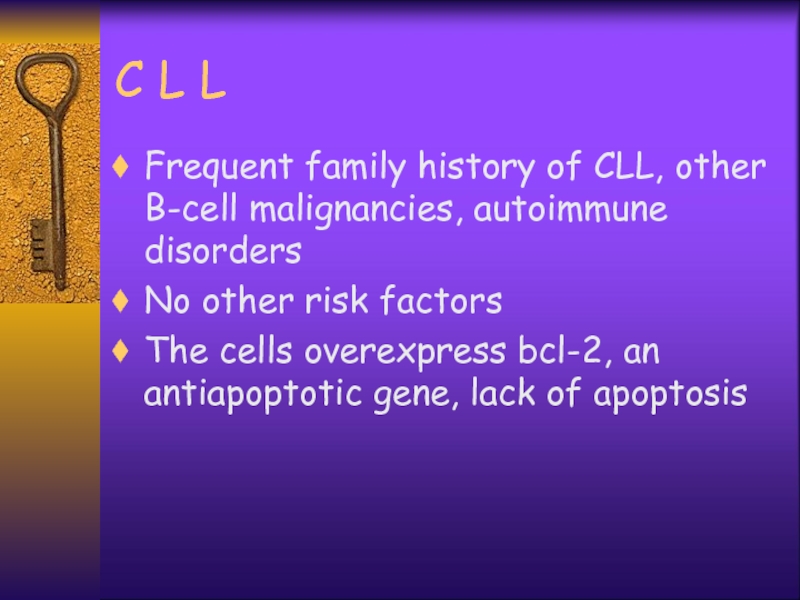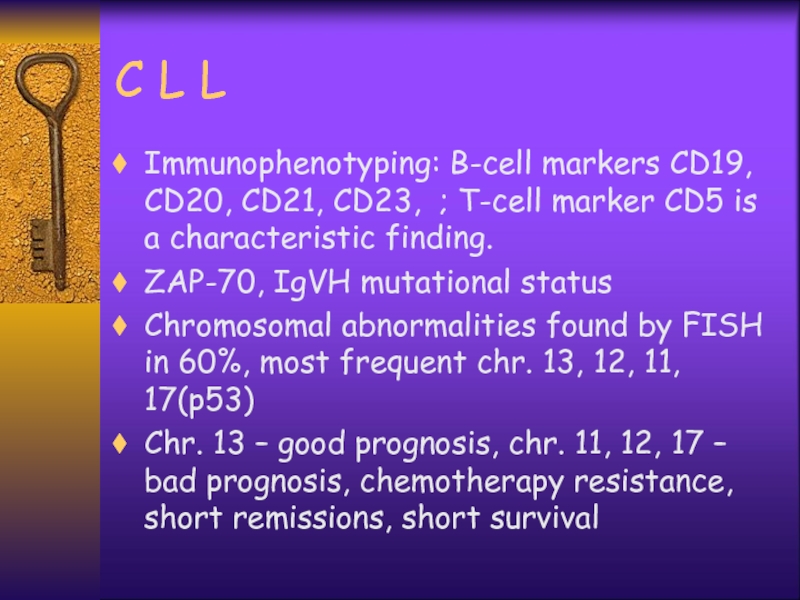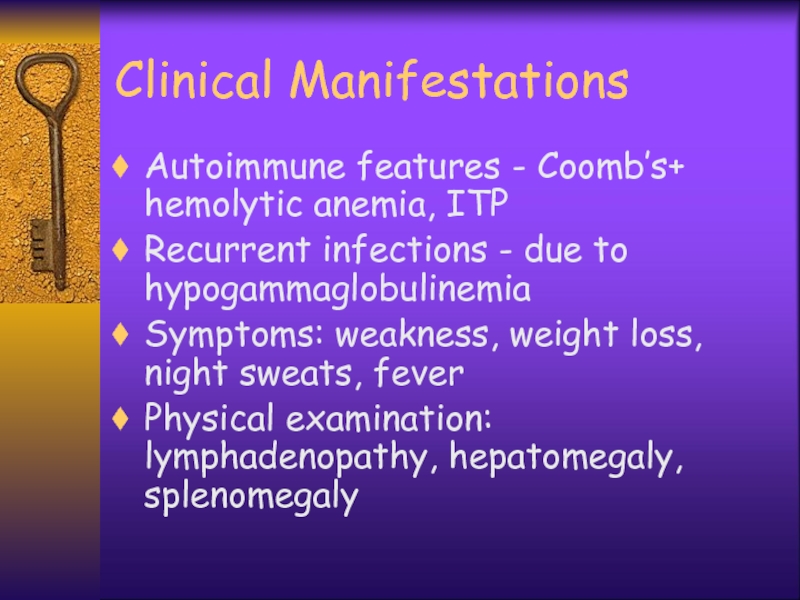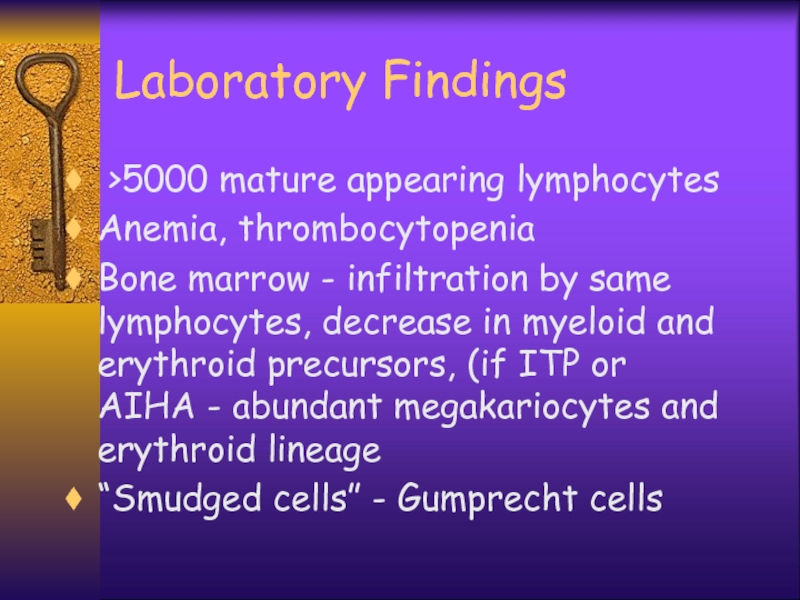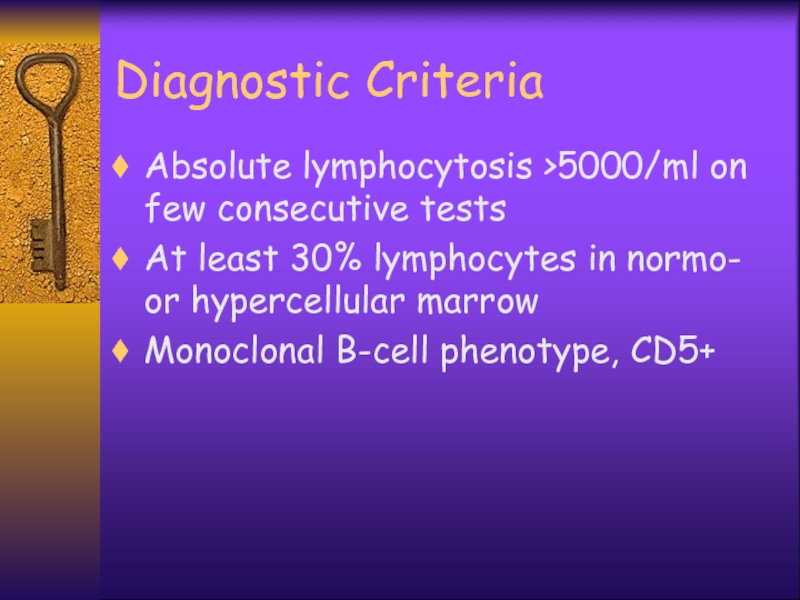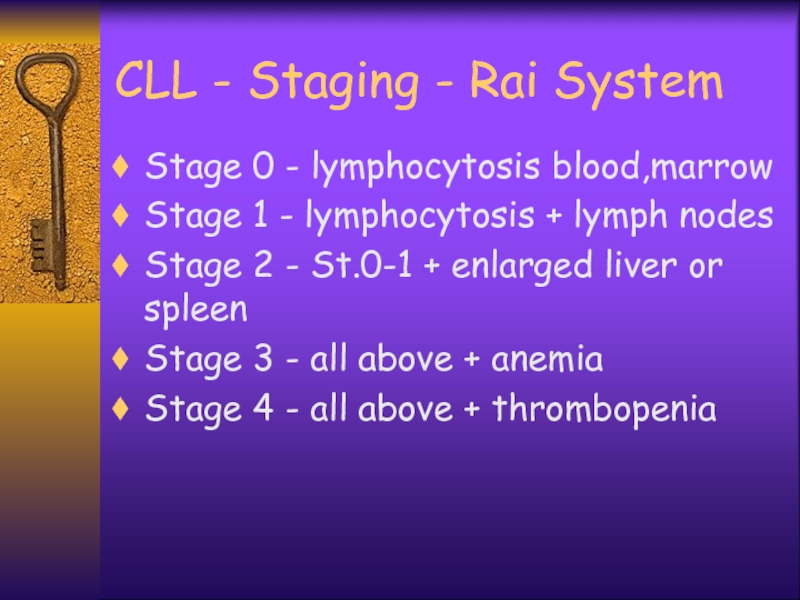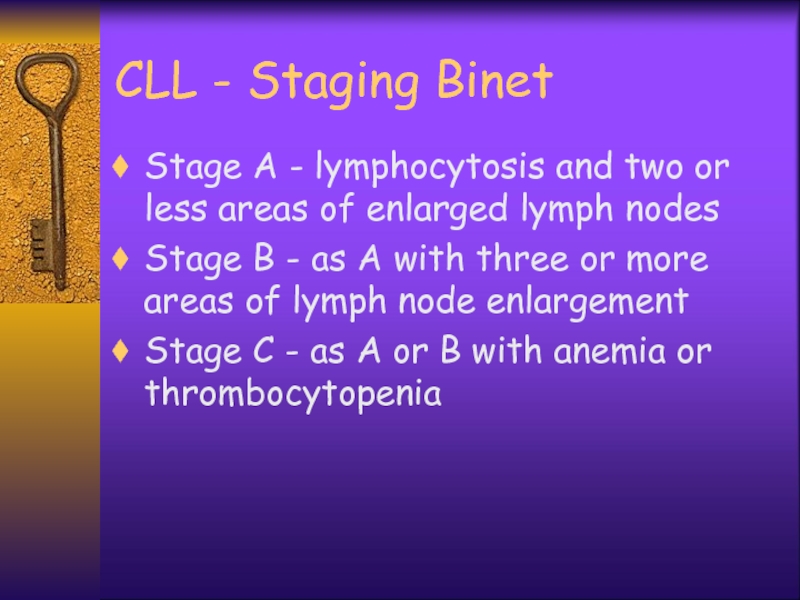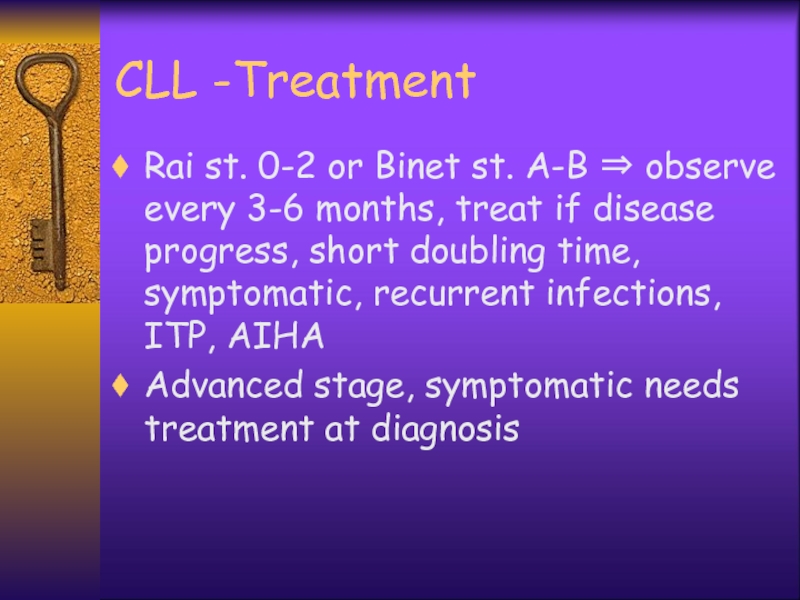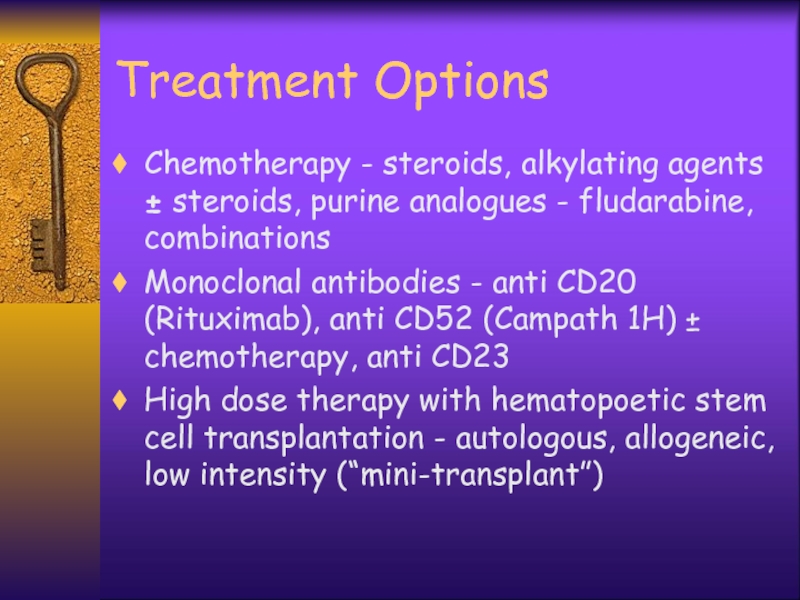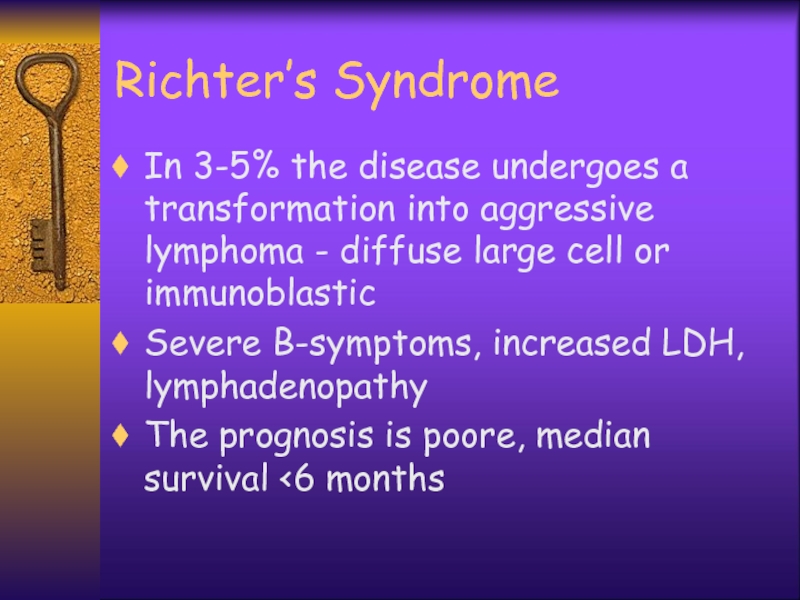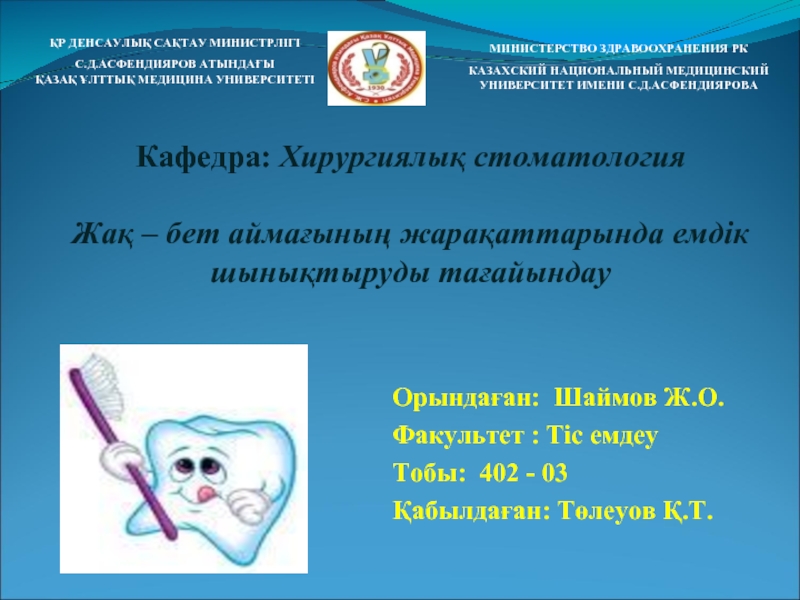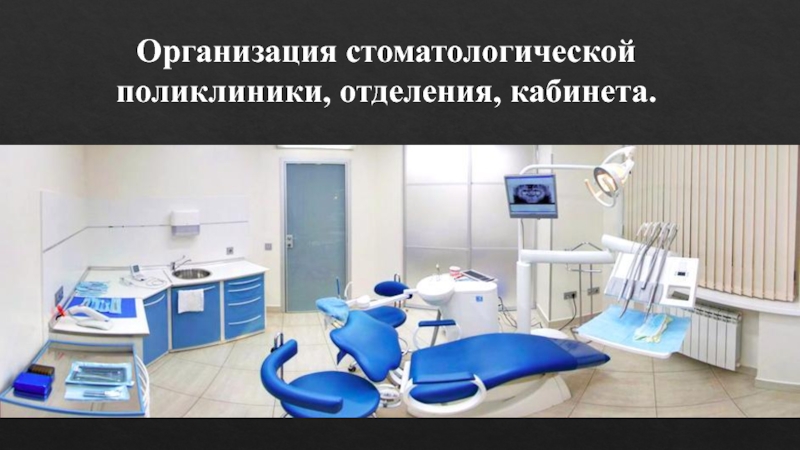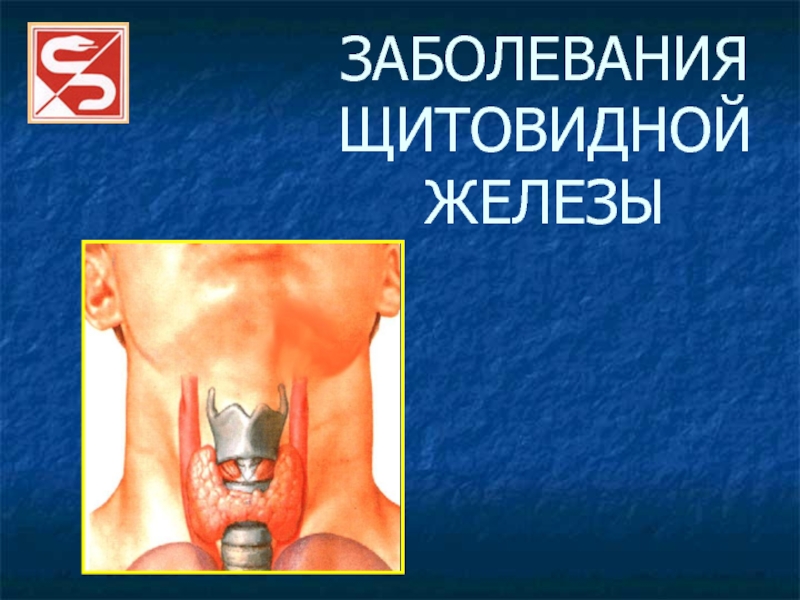HAIFA, ISRAEL
- Главная
- Разное
- Дизайн
- Бизнес и предпринимательство
- Аналитика
- Образование
- Развлечения
- Красота и здоровье
- Финансы
- Государство
- Путешествия
- Спорт
- Недвижимость
- Армия
- Графика
- Культурология
- Еда и кулинария
- Лингвистика
- Английский язык
- Астрономия
- Алгебра
- Биология
- География
- Детские презентации
- Информатика
- История
- Литература
- Маркетинг
- Математика
- Медицина
- Менеджмент
- Музыка
- МХК
- Немецкий язык
- ОБЖ
- Обществознание
- Окружающий мир
- Педагогика
- Русский язык
- Технология
- Физика
- Философия
- Химия
- Шаблоны, картинки для презентаций
- Экология
- Экономика
- Юриспруденция
The leukemia презентация
Содержание
- 1. The leukemia
- 2. TERMINOLOGY A malignant proliferation of monoclonal hematopoetic
- 3. Leukemias A very heterogeneic group of disorders,
- 4. AML – FAB classification M0 –
- 5. FAB classification This classification is based mostly
- 6. Cytogenetics Cytogenetics is the most important prognostic
- 7. AML – WHO classification AML with recurrent
- 8. ALL The FAB classification is not in
- 9. ETIOLOGY Environment: irradiation, chemotherapeutic agents, organic
- 10. CLINICAL FEAURES AML – 1.2% of all
- 11. CLINICAL FEATURES The presenting signs are not
- 12. LABORATORY Leukocytosis with blasts Metabolic and electrolyte
- 13. DIAGNOSIS Blasts in blood or bone marrow
- 14. Immunophenotyping CD – Cluster Designation, molecules on
- 15. AML - TREATMENT AML – induction with
- 16. ALL - TREATMENT Protocols based on treatment
- 17. CML A clonal expansion of hematopoetic progenitors,
- 18. C M L A phasic disease –
- 19. CML - cytogenetics The first malignancy in
- 21. CML Philadelphia chromosome – a short chromosome
- 23. CML pathogenesis The normal product of Abl
- 24. Clinical features Most patients are asymptomatic at
- 25. Laboratory Peripheral blood : leukocytosis with
- 26. Laboratory LAP (leukocyte alkaline phosphatase)↓ Transcobalamine↑ Uric
- 27. Accelerated Phase ↑Leukocytosis under treatment ↑Basophilia (>20%
- 28. BLAST CRISIS Developes in 75-80% of patients
- 29. TREATMENT Tyrosine kinase inhibitors - glyvec (imatinib
- 30. C L L A progressive accumulation of
- 31. C L L Frequent family history of
- 32. C L L Immunophenotyping: B-cell markers CD19,
- 33. Clinical Manifestations Autoimmune features - Coomb’s+ hemolytic
- 34. Laboratory Findings >5000 mature appearing lymphocytes
- 35. Diagnostic Criteria Absolute lymphocytosis >5000/ml on few
- 36. CLL - Staging - Rai System Stage
- 37. CLL - Staging Binet Stage A -
- 38. CLL -Treatment Rai st. 0-2 or Binet
- 39. Treatment Options Chemotherapy - steroids, alkylating agents
- 40. CLL - Prognosis Extremely variable - some
- 41. Richter’s Syndrome In 3-5% the disease undergoes
- 42. Second Malignancies Incidence of 8.9% (28% increased
Слайд 2TERMINOLOGY
A malignant proliferation of monoclonal hematopoetic cells with accumulation of abnormal
immature cells which replace a normal bone marrow.
Those cells retain the capacity to divide and proliferate, but lose the ability to differentiate terminally into mature hematopoetic cells and to die in a programmed cell death (apoptosis)
Those cells retain the capacity to divide and proliferate, but lose the ability to differentiate terminally into mature hematopoetic cells and to die in a programmed cell death (apoptosis)
Слайд 3Leukemias
A very heterogeneic group of disorders, can be classified on a
basis of clinical course as acute or chronic, on a basis of cell lineage – myelogenous or lymphatic
AML – Acute Myeloblastic Leukemia
ALL – Acute Lymphoblastic Leukemia
CML – Chronic Myeloid Leukemia
CLL – Chronic Lymphocytic Leukemia
AML – Acute Myeloblastic Leukemia
ALL – Acute Lymphoblastic Leukemia
CML – Chronic Myeloid Leukemia
CLL – Chronic Lymphocytic Leukemia
Слайд 4AML – FAB classification
M0 – undifferentiated
M1 – early myeloblastic
M2 – myelocytic
M3
– promyelocytic
M4 – myelomonocytic
M5 – monocytic/monoblastic
M6 – erythroid
M7 - megacariocytic
M4 – myelomonocytic
M5 – monocytic/monoblastic
M6 – erythroid
M7 - megacariocytic
Слайд 5FAB classification
This classification is based mostly on morphology and immunophenotyping of
the blasts
Has clinical and prognostic correlation, but not consistent
Updates should include cytogenetic features
Has clinical and prognostic correlation, but not consistent
Updates should include cytogenetic features
Слайд 6Cytogenetics
Cytogenetics is the most important prognostic feature of AML
“Favorable” –
M2 with t(8;21), M3 with t(15;17), M4eo with (inv 16)
Regular – normal caryotype
Unfavorable 11q23, 7q-, 5q-, trisomy 8, FLT-3 polymorphism, etc.
Regular – normal caryotype
Unfavorable 11q23, 7q-, 5q-, trisomy 8, FLT-3 polymorphism, etc.
Слайд 7AML – WHO classification
AML with recurrent cytogenetic translocations – M2 with
t(8;21), M3 with t(15;17) and variants, M4eo with (inv16), AML with 11q23 abnormalities
AML with multilineage dysplasia ± MDS
AML or MDS therapy related (alkylating agents, epydiphylotoxin, other)
FAB subtypes without other features
Acute biphenotypic leukemia
AML with multilineage dysplasia ± MDS
AML or MDS therapy related (alkylating agents, epydiphylotoxin, other)
FAB subtypes without other features
Acute biphenotypic leukemia
Слайд 8ALL
The FAB classification is not in use
Is classified by the phenotype
of the blasts – early B-lymphoblastic, T-lymphoblastic, mature B-lymphoblastic (Burkitt leukemia)
“Favorable” cytogenetics – t(12;21) in children
Unfavorable – Ph chromosome t(9;22), 11q23, t(4;11)
“Favorable” cytogenetics – t(12;21) in children
Unfavorable – Ph chromosome t(9;22), 11q23, t(4;11)
Слайд 9ETIOLOGY
Environment: irradiation, chemotherapeutic agents, organic solvents – benzene etc.
Genetic diseases:
neurofibromatosis, Wiscott-Aldrich synd., defective DNA repair – Fanconi, Down synd.
Acquired disorders: Aplastic Anemia, PNH
MOST OF THE CASES APPEAR WITH NO APPARENT RISK FACTORS!!!
Acquired disorders: Aplastic Anemia, PNH
MOST OF THE CASES APPEAR WITH NO APPARENT RISK FACTORS!!!
Слайд 10CLINICAL FEAURES
AML – 1.2% of all cancer deaths in US (about
9200 new cases per year), the incidence increases with age. In adults represents 90% of acute leukemias
ALL less prevalent in adults, the incidence increases in seventh and eighth decades of age
ALL less prevalent in adults, the incidence increases in seventh and eighth decades of age
Слайд 11CLINICAL FEATURES
The presenting signs are not specific:
Anemia – pallor, weakness, dispnoea
Neutropenia
– fever, infections
Thombocytopenia – bleeding, petechiae
Extramedullary - mild splenomegaly, skin involvement – leukemia cutis, chloromas, gingival hyperplasia more in monocytic or M2 with t(8;21), CNS more in ALL
Thombocytopenia – bleeding, petechiae
Extramedullary - mild splenomegaly, skin involvement – leukemia cutis, chloromas, gingival hyperplasia more in monocytic or M2 with t(8;21), CNS more in ALL
Слайд 12LABORATORY
Leukocytosis with blasts
Metabolic and electrolyte derangement hyperuricemia, hyperkalemia, hyperphosphatemia – tumor
lysis syndrome
Coagulopathy – DIC typical to APL
Coagulopathy – DIC typical to APL
Слайд 13DIAGNOSIS
Blasts in blood or bone marrow smear, Auer rods pathognomonic to
AML
Immunohistochemistry – peroxidase (AML), non specific esterase (monocytic), PAS (lymphoid, erytroid), acid phosphatase (lymphoid, erythroid, megacariocytic)
Immunohistochemistry – peroxidase (AML), non specific esterase (monocytic), PAS (lymphoid, erytroid), acid phosphatase (lymphoid, erythroid, megacariocytic)
Слайд 14Immunophenotyping
CD – Cluster Designation, molecules on the surface of the cell,
characteristic to each cell type, identified by monoclonal Ab.
CD33, CD34, CD11, CD13, CD14 – myeloid
CD41, CD61 – megakaryocytic
Glycophorin A – erythroid
CD2, CD3, CD4, CD7, CD8 – T lymphocytes
CD10, CD19, CD20, CD22 – B lymphocytes
CD33, CD34, CD11, CD13, CD14 – myeloid
CD41, CD61 – megakaryocytic
Glycophorin A – erythroid
CD2, CD3, CD4, CD7, CD8 – T lymphocytes
CD10, CD19, CD20, CD22 – B lymphocytes
Слайд 15AML - TREATMENT
AML – induction with ARA-C and daunorubicin (7:3); consolidations
with HIDAC and others, autologous HSCT, allogeneic HSCT, monoclonal Ab – conjugated anti-CD33 (Gemtuzumab Ozogamycine)
APL – ATRA, chemotherapy, Arsenic
APL – ATRA, chemotherapy, Arsenic
Слайд 16ALL - TREATMENT
Protocols based on treatment of childhood ALL, prolonged and
intensive therapy with CNS prophylaxis and maintenance
Autologous HSCT
Allogeneic HSCT
Autologous HSCT
Allogeneic HSCT
Слайд 17CML
A clonal expansion of hematopoetic progenitors, characterized clinically by myeloid hyperplasia,
leukocytosis with basophilia and splenomegaly
Слайд 18C M L
A phasic disease – chronic phase, accelerated phase, blast
crisis
Incidence – 1-2:100000
15-20% of leukemias in adults
Median age at diagnosis – 65 years
↑incidence in survivors of atomic bomb in Hiroshima and Nagasaki, atomic accident in Chernobyl
Incidence – 1-2:100000
15-20% of leukemias in adults
Median age at diagnosis – 65 years
↑incidence in survivors of atomic bomb in Hiroshima and Nagasaki, atomic accident in Chernobyl
Слайд 19CML - cytogenetics
The first malignancy in which the link between a
chromosomal abnormality and leukemogenesis was established
The Philadelphia chromosome – an abnormally short chromosome 22
The t(9;22) results from translocation of c-abl gene from chromosome 9 to bcr gene on chromosome 22, the new fusion gene – bcr/abl encodes a chimeric protein with strong unregulated tyrosine kinase activity
The Philadelphia chromosome – an abnormally short chromosome 22
The t(9;22) results from translocation of c-abl gene from chromosome 9 to bcr gene on chromosome 22, the new fusion gene – bcr/abl encodes a chimeric protein with strong unregulated tyrosine kinase activity
Слайд 21CML
Philadelphia chromosome – a short chromosome 22discovered at 1960 by Novel
and Henderford
First chromosomal Abnormality connected to malignancy
Caused by translocation t(9;22)(q34;q11)
Results in oncogen bcr/Abl that codes for a protein an unregulated Tyrosine Kinase
First chromosomal Abnormality connected to malignancy
Caused by translocation t(9;22)(q34;q11)
Results in oncogen bcr/Abl that codes for a protein an unregulated Tyrosine Kinase
Слайд 23CML pathogenesis
The normal product of Abl gene is a protein of
145kd with a week tyrosine kinase activity, strictly regulated and important in cell cycle regulation
The bcr/Abl product is 190,210 or 230kd protein with strong and autonomous TK activity, can causecell proliferation and malignant transformation and inhibit apoptosis. It’s substrate is oncogen ras which inhibits tumor suppressor gene p-53
The bcr/Abl product is 190,210 or 230kd protein with strong and autonomous TK activity, can causecell proliferation and malignant transformation and inhibit apoptosis. It’s substrate is oncogen ras which inhibits tumor suppressor gene p-53
Слайд 24Clinical features
Most patients are asymptomatic at diagnosis
Splenomegaly ± symptoms, anemia, hepatomegaly,
purpura, constitutional symptoms – fatigue, anorexia, weight loss,sweats,low grade fever, hyperleukocytosis,bone pain (rare in chronic phase), priapism
Слайд 25Laboratory
Peripheral blood : leukocytosis with “left shift”, basophillia, eeosinophilia, thrombocytosis,
anemia
Bone marrow: myeloid (M:E•3:1), blasts •10%, no dysplasia, abundant megacaryocytes, fibrosis, monocytes•3%
Слайд 26Laboratory
LAP (leukocyte alkaline phosphatase)↓
Transcobalamine↑
Uric acid↑
Cytogenetics - Ph+ {t(9;22)}
Molecular - bcr/abl +
Gene
expression pattern (experimental)
Слайд 27Accelerated Phase
↑Leukocytosis under treatment
↑Basophilia (>20% basophils and eosinophils
>10% blasts in peripheral
blood
>20% blasts + promyelocytes in marrow
Thrombocytosis
Additional chromosomal abnormalities
>20% blasts + promyelocytes in marrow
Thrombocytosis
Additional chromosomal abnormalities
Слайд 28BLAST CRISIS
Developes in 75-80% of patients
Median time from diagnosis 3-5 years
constitutional
symptoms, bone pain, extramedullary (skin, lymph nodes, CNS)
>30% blasts in bone marrow
Additional chromosomal abnormalities
50% - myeloid, 25% - lymphoid, 25% - biphenotypic
>30% blasts in bone marrow
Additional chromosomal abnormalities
50% - myeloid, 25% - lymphoid, 25% - biphenotypic
Слайд 29TREATMENT
Tyrosine kinase inhibitors - glyvec (imatinib mesylate), nilotinib, dasatinib etc., major
cytogenetic and molecular responses in over 80%, changed a natural history of the disease
Chemotherapy – hydrea, busulphan, ARA-C
α-Interferon - 15% cytogenetic response with prolonged survival
Allogeneic bone marrow transplant, 45-70% long term survival, curative. In TKI`s resistant or intolerant cases.
Chemotherapy – hydrea, busulphan, ARA-C
α-Interferon - 15% cytogenetic response with prolonged survival
Allogeneic bone marrow transplant, 45-70% long term survival, curative. In TKI`s resistant or intolerant cases.
Слайд 30C L L
A progressive accumulation of functionally incompetent mature lymphocytes
15-20% of
all leukemias, M:F=1.7:1
>95% B-CLL; 2-5% T-CLL
In people > 70, incidence 20/100000, median age at diagnosis 55
>95% B-CLL; 2-5% T-CLL
In people > 70, incidence 20/100000, median age at diagnosis 55
Слайд 31C L L
Frequent family history of CLL, other B-cell malignancies, autoimmune
disorders
No other risk factors
The cells overexpress bcl-2, an antiapoptotic gene, lack of apoptosis
No other risk factors
The cells overexpress bcl-2, an antiapoptotic gene, lack of apoptosis
Слайд 32C L L
Immunophenotyping: B-cell markers CD19, CD20, CD21, CD23, ; T-cell
marker CD5 is a characteristic finding.
ZAP-70, IgVH mutational status
Chromosomal abnormalities found by FISH in 60%, most frequent chr. 13, 12, 11, 17(p53)
Chr. 13 – good prognosis, chr. 11, 12, 17 – bad prognosis, chemotherapy resistance, short remissions, short survival
ZAP-70, IgVH mutational status
Chromosomal abnormalities found by FISH in 60%, most frequent chr. 13, 12, 11, 17(p53)
Chr. 13 – good prognosis, chr. 11, 12, 17 – bad prognosis, chemotherapy resistance, short remissions, short survival
Слайд 33Clinical Manifestations
Autoimmune features - Coomb’s+ hemolytic anemia, ITP
Recurrent infections - due
to hypogammaglobulinemia
Symptoms: weakness, weight loss, night sweats, fever
Physical examination: lymphadenopathy, hepatomegaly, splenomegaly
Symptoms: weakness, weight loss, night sweats, fever
Physical examination: lymphadenopathy, hepatomegaly, splenomegaly
Слайд 34Laboratory Findings
>5000 mature appearing lymphocytes
Anemia, thrombocytopenia
Bone marrow - infiltration
by same lymphocytes, decrease in myeloid and erythroid precursors, (if ITP or AIHA - abundant megakariocytes and erythroid lineage
“Smudged cells” - Gumprecht cells
“Smudged cells” - Gumprecht cells
Слайд 35Diagnostic Criteria
Absolute lymphocytosis >5000/ml on few consecutive tests
At least 30% lymphocytes
in normo- or hypercellular marrow
Monoclonal B-cell phenotype, CD5+
Monoclonal B-cell phenotype, CD5+
Слайд 36CLL - Staging - Rai System
Stage 0 - lymphocytosis blood,marrow
Stage 1
- lymphocytosis + lymph nodes
Stage 2 - St.0-1 + enlarged liver or spleen
Stage 3 - all above + anemia
Stage 4 - all above + thrombopenia
Stage 2 - St.0-1 + enlarged liver or spleen
Stage 3 - all above + anemia
Stage 4 - all above + thrombopenia
Слайд 37CLL - Staging Binet
Stage A - lymphocytosis and two or less
areas of enlarged lymph nodes
Stage B - as A with three or more areas of lymph node enlargement
Stage C - as A or B with anemia or thrombocytopenia
Stage B - as A with three or more areas of lymph node enlargement
Stage C - as A or B with anemia or thrombocytopenia
Слайд 38CLL -Treatment
Rai st. 0-2 or Binet st. A-B ⇒ observe every
3-6 months, treat if disease progress, short doubling time, symptomatic, recurrent infections, ITP, AIHA
Advanced stage, symptomatic needs treatment at diagnosis
Advanced stage, symptomatic needs treatment at diagnosis
Слайд 39Treatment Options
Chemotherapy - steroids, alkylating agents ± steroids, purine analogues -
fludarabine, combinations
Monoclonal antibodies - anti CD20 (Rituximab), anti CD52 (Campath 1H) ± chemotherapy, anti CD23
High dose therapy with hematopoetic stem cell transplantation - autologous, allogeneic, low intensity (“mini-transplant”)
Monoclonal antibodies - anti CD20 (Rituximab), anti CD52 (Campath 1H) ± chemotherapy, anti CD23
High dose therapy with hematopoetic stem cell transplantation - autologous, allogeneic, low intensity (“mini-transplant”)
Слайд 40CLL - Prognosis
Extremely variable - some have progressive course and die
within 2-3 years, some have indolent disease with 10-20 years survival
The prognostic factors are - stage at diagnosis, cytogenetics, molecular – mutation status, ZAP-70, CD38 expression; morphology – diffuse bone marrow infiltration, large cells (prolymphocytes), T-lineage, B-symptoms, high LDH, short doubling time
The prognostic factors are - stage at diagnosis, cytogenetics, molecular – mutation status, ZAP-70, CD38 expression; morphology – diffuse bone marrow infiltration, large cells (prolymphocytes), T-lineage, B-symptoms, high LDH, short doubling time
Слайд 41Richter’s Syndrome
In 3-5% the disease undergoes a transformation into aggressive lymphoma
- diffuse large cell or immunoblastic
Severe B-symptoms, increased LDH, lymphadenopathy
The prognosis is poore, median survival <6 months
Severe B-symptoms, increased LDH, lymphadenopathy
The prognosis is poore, median survival <6 months
Слайд 42Second Malignancies
Incidence of 8.9% (28% increased risk) of second malignancy
Most frequent
cancers associated with CLL are - skin,lung, gastrointestinal tumors (ca of colon)
There is no relationship between the course of CLL, it’s treatment and the incidence of second cancers
There is no relationship between the course of CLL, it’s treatment and the incidence of second cancers
